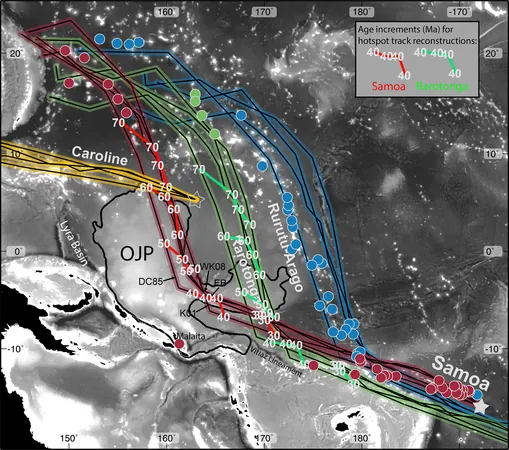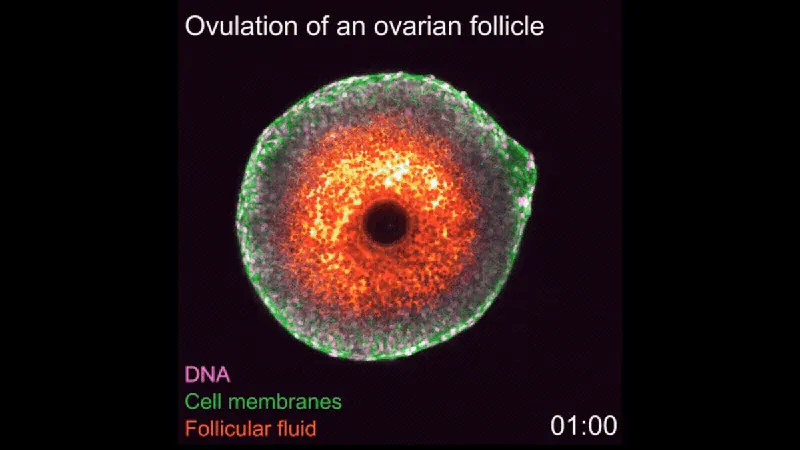
Unearthing the Secrets of Samoa's Disappearing Mantle Plume: A 30-Million-Year Mystery Finally Solved!
2024-10-28
Author: John Tan
Introduction
Recent research has illuminated one of Earth's intriguing geological puzzles: the 30-million-year gap in the volcanic history of the Samoan Islands, which are part of the broader Pacific hotspot track that includes the notable Hawaiian Islands. Scientists have long been fascinated by how magma plumes, which rise through the Earth's lithosphere, create surface features such as volcanoes and islands while revealing critical information about our planet's past.
Groundbreaking Findings
A team led by M. G. Jackson recently published groundbreaking findings in the journal AGU Advances, providing insights into why there is a missing segment in the Samoan hotspot track. They traced the origins of this gap back to the movement of the Pacific tectonic plate approximately 60 million years ago, which transported the expansive Ontong Java Plateau—known for its thick volcanic lithosphere—over the Samoan plume. This geological phenomenon effectively sealed the plume for 30 million years, resulting in the waning of volcanic activity, and thus the gap that researchers were puzzled by.
Research Methodology
The researchers' investigation combined isotopic and geochronological analyses of lava samples with sophisticated plate motion models. A critical discovery emerged from volcanic rocks located on the island of Malaita in the Solomon Islands, approximately 3,000 kilometers east of Samoa. These rocks, dating back 44 million years, possess geochemical signatures closely related to the lavas from the Samoan hotspot, suggesting that they share a common origin, thus bridging that 30-million-year gap.
Proposed Scenarios
The study proposes two scenarios regarding the Ontong Java Plateau's influence on the Samoan plume—either suppressing or redirecting magma flow. However, the Malaita samples might be a significant exception, indicating that some volcanic activity could still have occurred despite the plateau's imposing presence. This concept introduces a previously unrecognized interaction termed "plume-plateau interactions," which could reshape existing theories regarding hotspot activity.
Broader Implications
Moreover, the research hints that this phenomenon is not isolated; evidence suggests that other volcanic provinces, like the Manihiki Plateau, similarly inhibited the activity of nearby hot spots, such as those that contributed to the formation of the Pitcairn and Society Islands. This raises important questions about how often such interactions occur and their implications on our understanding of volcanic processes.
Commentary and Considerations
In her accompanying commentary, Shichun Huang raises further considerations about how the thickness of a plateau may not always suffice to prevent melting entirely, potentially distorting our understanding of the material composition derived from hotspots. This means that some hot spot lavas might not accurately reflect the deeper mantle dynamics from which they arise, casting doubt on existing assumptions about the richness of material sourced from these geological features.
Conclusion
Overall, the new revelations not only enhance our understanding of the Samoan mantle plume but also shed light on broader dynamics between tectonic plates and volcanic activity. This groundbreaking research invites us to reconsider how these interactions might impact global geological processes, leading to exciting new hypotheses waiting to be explored!



 Brasil (PT)
Brasil (PT)
 Canada (EN)
Canada (EN)
 Chile (ES)
Chile (ES)
 España (ES)
España (ES)
 France (FR)
France (FR)
 Hong Kong (EN)
Hong Kong (EN)
 Italia (IT)
Italia (IT)
 日本 (JA)
日本 (JA)
 Magyarország (HU)
Magyarország (HU)
 Norge (NO)
Norge (NO)
 Polska (PL)
Polska (PL)
 Schweiz (DE)
Schweiz (DE)
 Singapore (EN)
Singapore (EN)
 Sverige (SV)
Sverige (SV)
 Suomi (FI)
Suomi (FI)
 Türkiye (TR)
Türkiye (TR)